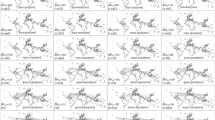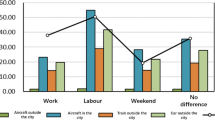Abstract
This study examined the spatio-temporal trajectories of the international freight forwarding service (IFFS) in the Yangtze River Delta (YRD) and explored the driving mechanisms of the service. Based on a bipartite network projection from an IFFS firm-city data source, we mapped three IFFS networks in the YRD in 2005, 2010, and 2015. A range of statistical indicators were used to explore changes in the spatial patterns of the three networks. The underlying influence of marketization, globalization, decentralization, and integration was then explored. It was found that the connections between Shanghai and other nodal cities formed the backbones of these networks. The effects of a city’s administrative level and provincial administrative borders were generally obvious. We found several specific spatial patterns associated with IFFS. For example, the four non-administrative centers of Ningbo, Suzhou, Lianyungang, and Nantong were the most connected cities and played the role of gateway cities. Furthermore, remarkable regional equalities were found regarding a city’s IFFS network provision, with notable examples in the weakly connected areas of northern Jiangsu and southwestern Zhejiang. Finally, an analysis of the driving mechanisms demonstrated that IFFS network changes were highly sensitive to the influences of marketization and globalization, while regional integration played a lesser role in driving changes in IFFS networks.
Similar content being viewed by others
References
Alderson A S, Beckfield J, 2004. Power and position in the world city system. American Journal of Sociology, 109(4): 811–851. doi: 10.1086/378930
Alderson A S, Beckfield J, Sprague-Jones J, 2010. Intercity relations and globalisation: the evolution of the global urban hierarchy, 1981–2007. Urban Studies, 47(9): 1899–1923. doi: 10.1177/0042098010372679
Burger M J, Van Der Knaap B, Wall R S, 2014. Polycentricity and the multiplexity of urban networks. European Planning Studies, 22(4): 816–840. doi: 10.1080/09654313.2013.771619
Camagni R, Capello R, 2004. The city network paradigm: theory and empirical evidence. In: Capello R, Nijkamp P (eds). Urban Dynamics and Growth: Advances in Urban Economics. Amsterdam: Elsevier, 495–529.
Cao Weidong, 2011. Spatial pattern and location evolution of urban logistics enterprises: taking Suzhou as an example. Geographical Research, 30(11): 1997–2007. (in Chinese)
Cao Weidong, 2012. Study on location Features and spatial correlation of port enterprises: taking Shanghai port backup area as an example. Geographical Research, 31(6): 1079–1088. (in Chinese)
Castells M, 1996. The Rise of the Network Society. Oxford: Blackwell.
Cidell J, 2010. Concentration and decentralization: the new geography of freight distribution in US metropolitan areas. Journal of Transport Geography, 18(3): 363–371. doi: 10.1016/j.jtrangeo.2009.06.017
De Goei B, Burger M J, Van Oort F G et al., 2010. Functional polycentrism and urban network development in the Greater South East, United Kingdom: evidence from commuting patterns, 1981–2001. Regional Studies, 44(9): 1149–1170. doi: 10.1080/00343400903365102
Derudder B, Cao Z, Liu X J et al., 2018. Changing connectivities of Chinese cities in the world city network, 2010–2016. Chinese Geographical Science, 28(2): 183–201. doi: 10.1007/s11769-018-0938-6
Ducruet C, Beauguitte L, 2014. Spatial science and network science: review and outcomes of a complex relationship. Networks and Spatial Economics, 14(3–4): 297–316. doi: 10.1007/s11067-013-9222-6
Hall P, Pain K, 2006. The Polycentric Metropolis: Learning from Mega–City Regions in Europe. London: Earthscan.
He Canfei, Liu Zuoli, Wang Liang, 2008. Economic transition and convergence of regional industrial structure in China. Acta Geographica Sinica, 63(8): 807–819. (in Chinese)
Hesse M, Rodrigue J P, 2004. The transport geography of logistics and freight distribution. Journal of Transport Geography, 12(3): 171–184. doi: 10.1016/j.jtrangeo.2003.12.004
Hino M, 2005. Implications of recent decrease in the agglomeration of branch offices in regional cities in Japan. In Murayama, Y. and Du, G. (eds.). Cities in Global Perspective: Diversity and Transition. Tokyo: College of Tourism. Rikkyo University with IGU Urban Commission, 212–218.
Ji Feifei, Chen Wen, 2014. Distribution pattern and expansion mechanism of financial institution network in the Yangtze River Delta. Progress in Geography, 33(9): 1241–1251. (in Chinese)
JSB (Jiangsu Statistics Bureau), 2006. Jiangsu Statistical Yearbook 2006. Beijing: China Statistics Press. (in Chinese)
JSB (Jiangsu Statistics Bureau), 2011. Jiangsu Statistical Yearbook 2011. Beijing: China Statistics Press. (in Chinese)
JSB (Jiangsu Statistics Bureau), 2016. Jiangsu Statistical Yearbook 2016. Beijing: China Statistics Press. (in Chinese)
Krackhardt D, 1988. Predicting with networks: nonparametric multiple regression analysis of dyadic data. Social Networks, 10(4): 359–381. doi: 10.1016/0378-8733(88)90004-4
Li Y, Wu F L, 2013. The emergence of centrally initiated regional plan in China: a case study of Yangtze River Delta Regional Plan. Habitat International, 39: 137–147. doi: 10.1016/j.habitatint.2012.11.002
Li Y C, Phelps N A, 2017. Knowledge polycentricity and the evolving Yangtze River Delta megalopolis. Regional Studies, 51(7): 1035–1047. doi: 10.1080/00343404.2016.1240868
Li Y C, Phelps N A, 2018. Megalopolis unbound: Knowledge collaboration and functional polycentricity within and beyond the Yangtze River Delta Region in China, 2014. Urban Studies, 55(2): 443–460. doi: 10.1177/0042098016656971
Liang Shuangbo, Cao Youhui, Wu Wei, 2013. Spatial pattern evolution of port logistics enterprises in Shanghai metropolitan area. Geographical Research, 32(8): 1448–1456. (in Chinese)
Liu X J, Derudder B, Wu K, 2016. Measuring polycentric urban development in China: an intercity transportation network perspective. Regional Studies, 50(8): 1302–1315. doi: 10.1080/00343404.2015.1004535
Mei Zanbin, Liu Jianxin, 2010. China International Freight Forwarding Industry Development Research Report. Beijing, China: China Logistics Publishing House. (in Chinese)
Mo Xing, Qian Qinglan, Guo Qin et al., 2010. Spatial distribution features of the transportation–oriented logistics enterprises in Guangzhou. Tropical Geography, 30(5): 521–527. (in Chinese)
NBSC (National Bureau of Statistics of the People’s Republic of China), 2006. China Statistical Yearbook 2006. Beijing: China Statistics Press. (in Chinese)
NBSC (National Bureau of Statistics of the People’s Republic of China), 2011. China Statistical Yearbook 2011. Beijing: China Statistics Press. (in Chinese)
Notteboom T E, 2002. Consolidation and contestability in the European container handling industry. Maritime Policy & Management, 29(3): 257–269. doi: 10.1080/03088830210132614
O’Connor K, 2010. Global city regions and the location of logistics activity. Journal of Transport Geography, 18(3): 354–162. doi: 10.1016/j.jtrangeo.2009.06.015
Pan F H, Bi W K, Lenzer J et al., 2017. Mapping urban networks through inter-firm service relationships: the case of China. Urban Studies, 54(16): 3639–3654. doi: 10.1177/0042098016685511
Parnreiter C, 2014. Network or hierarchical relations? A plea for redirecting attention to the control functions of global cities. Tijdschrift Voor Economische en Sociale Geografie, 105(4): 398–411. doi: 10.1111/tesg.12095
Qian Y Y, Weingast B R, 1997. Federalism as a commitment to reserving market incentives. Journal of Economic Perspectives, 11(4): 83–92. doi: 10.1257/jep.11.4.83
Robinson R, 2002. Ports as elements in value–driven chain systems: the new paradigm. Maritime Policy & Management, 29(3): 241–255. doi: 10.1080/03088830210132623
Shearmur R, Doloreux D, 2015. Central places or networks? Paradigms, metaphors, and spatial configurations of innovation–related service use. Environment and Planning A: Economy and Space, 47(7): 1521–1539. doi: 10.1177/0308518X15595770
Smith D A, Timberlake M F, 2001. World city networks and hierarchies, 1977–1997: an empirical analysis of global air travel links. American Behavioral Scientist, 44(10): 1656–1678. doi: 10.1177/00027640121958104
Song Weixuan, Chen Wen, Peng Ying, 2013. Spatial pattern of urban–rural income under the background of regional integration the Changjiang River Delta. Scientia Geographica Sinica, 33(9): 1037–1042. (in Chinese)
SSB (Shanghai Statistics Bureau), 2006. Shanghai Statistical Yearbook 2006. Beijing: China Statistics Press. (in Chinese)
SSB (Shanghai Statistics Bureau), 2011. Shanghai Statistical Yearbook 2011. Beijing: China Statistics Press. (in Chinese)
SSB (Shanghai Statistics Bureau), 2016. Shanghai Statistical Yearbook 2016. Beijing: China Statistics Press. (in Chinese)
State Council, 2001. Suggestions on Deepening the Institutional Reform of the Central Leadership and the Dual Leadership on Ports. Available at: http://www.gov.cn/gongbao/content/2002/content_61548.htm. 2001-11-23. Cited 17 Oct 2018.
Taylor P J, 2001. Specification of the world city network. Geographical Analysis, 33(2): 181–194. doi: 10.1111/j.1538-4632.2001.tb00443.x
Taylor P J, Derudder B, 2016. World City Network: A Global Urban Analysis. 2nd ed. London: Routledge.
Wang Chengjin, 2008a. Spatial organizational network of loigsitcs company in China. Acta Geographica Sinica, 63(2): 135–146. (in Chinese)
Wang Chengjin, 2008b. International reorganization of shipping liners and its effect on world network structure. World Regional Studies, 17(1): 94–104, 118. (in Chinese)
Wang Cong, Cao Youhui, Yao Shimou et al., 2013. Spatial difference of urban globalization process in Changjiang River Delta Region: a case study of two provinces and one city. Scientia Geographica Sinica, 33(7): 779–788. (in Chinese)
Wang Cong, Cao Youhui, Chen Guowei, 2014. Study on urban network of Yangtze River Delta region based on producer services. Geographical Research, 33(2): 323–335. (in Chinese)
Wang J J, Cheng M C, 2010. From a hub port city to a global supply chain management center: a case study of Hong Kong. Journal of Transport Geography, 18(1): 104–115. doi: 10.1016/j.jtrangeo.2009.02.009
Wang Jiao’e, Jing Yue, 2017. Comparison of spatial structure and organization mode of inter–city networks from the perspective of railway and air passenger flow. Acta Geographica Sinica, 72(8): 1508–1519. (in Chinese)
Wei Y D, 1994. Urban policy, economic policy, and the growth of large cities in China. Habitat International, 18(4): 53–65.
Wei Y D, Li W M, 2002. Reforms, globalization, and urban growth in China: the case of Hangzhou. Eurasian Geography and Economics, 43(6): 459–475. doi: 10.2747/1538-7216.43.6.459
Wu Jiawei, Yuan Feng, Lv Weiguo et al., 2014. Spatiotemporal change of foreign direct investment and mechanism in the Pan-Yangtze River Delta area under the global financial crisis. Progress in Geography, 33(12): 1601–1613. (in Chinese)
Wu Qianbo, Ning Yuemin, 2012. China’s urban network based on spatial organization of electronic information enterprises. Geographical Research, 31(2): 207–219. (in Chinese)
Ye Shilin, Cao Youhui, Wang Jiawei et al., 2017. Organization network of Chinese container transportation from the perspective of enterprises. Acta Geographica Sinica, 72(8): 1520–1530. (in Chinese)
Zhang Haohan, 2013. Research on regional integration transformation and integration system construction — taking Yangtze River Delta as an example. Journal of PLA Nanjing Institute of Politics, 29(1): 69–76. (in Chinese)
Zhang W Y, Derudder B, Wang J H et al., 2016. Using Location–based social media to chart the patterns of people moving between cities: the case of Weibo–Users in the Yangtze River Delta. Journal of Urban Technology, 23(3): 91–111. doi: 10.1080/10630732.2016.1177259
Zhang W Y, Derudder B, Wang J H et al., 2017. Regionalization in the Yangtze River Delta, China, from the perspective of inter–city daily mobility. Regional Studies, 2018, 52(4): 528–541. doi: 10.1080/00343404.2017.1334878
Zhao M X, Derudder B, Huang J H, 2017. Polycentric development in China’s mega-city regions, 2001–08: a comparison of the Yangtze and Pearl River Deltas. DIE ERDE–Journal of the Geographical Society of Berlin, 148(1): 1–13. doi: 10.12854/erde-148-26
Zhao Miaoxi, Wei Jiming, Wu Kang, 2014. Functional linkages in the Beijing–Tianjin–Hebei conurbation region and the evolution of the complex networks. Urban Planning Forum, (1): 46–52. (in Chinese)
Zhen Feng, Wang Bo, Chen Yingxue, 2012. China’s city network characteristics based on social network space: an empirical analysis of Sina micro–blog. Acta Geographica Sinica, 67(8): 1031–1043. (in Chinese)
Zong Huiming, Zhou Suhong, Yan Xiaopei, 2011. The development of logistics industry in Shenzhen under the global production networks: a trade and logistics perspective. Urban Insight, (6): 5–15. (in Chinese)
ZSB (Zhejiang Statistics Bureau), 2006. Zhejiang Statistical Yearbook 2006. Beijing: China Statistics Press. (in Chinese)
ZSB (Zhejiang Statistics Bureau), 2011. Zhejiang Statistical Yearbook 2011. Beijing: China Statistics Press. (in Chinese)
ZSB (Zhejiang Statistics Bureau), 2016. Zhejiang Statistical Yearbook 2016. Beijing: China Statistics Press. (in Chinese)
Author information
Authors and Affiliations
Corresponding author
Additional information
Foundation item: Under the auspices of National Natural Science Foundation of China (No. 41671132, 41771139), Natural Science Foundation of Jiangsu Province (No. BK20171516)
Rights and permissions
About this article
Cite this article
Liang, S., Cao, Y., Wu, W. et al. International Freight Forwarding Services Network in the Yangtze River Delta, 2005–2015: Patterns and Mechanisms. Chin. Geogr. Sci. 29, 112–126 (2019). https://doi.org/10.1007/s11769-019-1018-2
Received:
Accepted:
Published:
Issue Date:
DOI: https://doi.org/10.1007/s11769-019-1018-2




